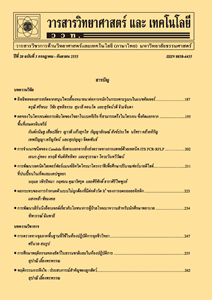การวิเคราะห์หาปริมาณซัลไฟต์ด้วยระบบโฟลอินเจคชันคัลเลอริเมตริกโดยใช้รีเอเจนต์จากธรรมชาติ
Main Article Content
Abstract
Abstract
The use of chemicals and waste generation from laboratory is one way to cause environmental pollution. As a result, the research in analytical chemistry is concerns to make laboratory practices to be more environmentally friendly, such as reduction or elimination of the use of hazardous chemicals, which are toxic to the environment. This work applied the flow injection analysis using roselle (Hibiscus sabdariffa L.) extract as a natural reagent for determination of sulfite. This method reduced the use of synthetic reagent. The dried roselle extract was prepared in acetate buffer (pH 3) and the red color was obtained. When reacted with sulfite, the color of the extract was decreased. The decreasing of color intensity could be measured by a laboratory made colorimeter. The calibration graph obtained was linear over the range of 5-100 mg/L. The method can be applied to determine the sulfite content in beverages samples.
Keywords: sulfite; flow injection; natural reagent
Article Details
References
[2] Vally, H., Misso, N.L.A. and Madan, V., 2009, Clinical effects of sulphite additives, Clin. Exp. Allergy 39: 1643-1651.
[3] Claudia, R.C. and Francisco, J.C, 2009, Application of flow injection analysis for determining sulphites in food and beverages: A review, Food Chem. 112: 487-493.
[4] Hillery, B.R., Elkins, E.R., Warner, C.R., Daniels, D., Fazio, T. and Balazs, P., 1989, Optimized Monier-Williams method for determination of sulfites in foods: Collaborative study, J. Assoc. Off. Anal. Chem. 72: 470-475.
[5] Kim, H.J., 1990, Determination of sulfite in foods and beverages by ion exclusion chromatography with electrochemical detection, J. Assoc. Off. Anal. Chem. 73: 216-222.
[6] Zoecklein, B.W., Fugelsang, K.C., Gump, B.H. and Nury, F.S., 1999, Sulfur Dioxide and Ascorbic Acid, pp. 178-191, In Zoecklein, B.W., Fugelsang, K.C., Gump, B.H. and Nury, F.S. (Eds.), Wine Analysis and Production, Springer, Boston.
[7] Sullivan, J.J., Hollingworth, T.A., Wekell, M.M., Newton, R.T. and Larose, J.E., 1986, Determination of sulfite in food by flow injection analysis, J. Assoc. Off. Anal. Chem. 69: 542-546.
[8] Sullivan, J.J., Hollingworth, T.A., Wekell, M.M., Meo, V.A., Etemad, M.A., Phillips, J.G. and Gump, B.H., 1990, Determination of free (pH 2.2) sulfite in wines by flow injection analysis: Collaborative study, J. Assoc. Off. Anal. Chem. 73: 223-226.
[9] Srivastava, S., Sinha, R. and Roy, D., 2004, Toxicological effects of malachite green, Aquat. Toxicol. 66: 319-329.
[10] Gałuszka, A., Migaszewski, Z. And Namiešnik, J., 2013, The 12 principles of green analytical chemistry and the SIGNIFICANCE mnemonic of green analytical practices, Trends Anal. Chem. 50: 78-84.
[11] Li, H. and Deng, Z.Y., 2014, Structure, Composition and Bioactivities of Anthocyanins in Vegetables and Fruits, pp. 295-317, In Warner, L.M. (Ed.), Handbook of Anthocyanins: Food Sources, Chemical Applications and Health Benefits, Nova Science Publishers, New York.
[12] Velisek, J., 2013, Pigments and other Colorants, pp. 656-740, In Velisek, J. (Ed.) The Chemistry of Food, Wiley, Oxford.
[13] Soares, M.H.F.B., Ramos, L.A. and Cavalheiro, É.T.G., 2002, Spectrophoto-metric determination of total sulfite in white wine samples using crude extracts from flowers, J. Chem. Educ. 79: 1111-1113.
[14] Rocha, I.D.C., Bonnlaender, B., Sievers, H., Pischel, I. and Heinrich, M., 2014, Hibiscus sabdariffa L. – A phytochemical and pharmacological review, Food Chem. 165: 424-443.


